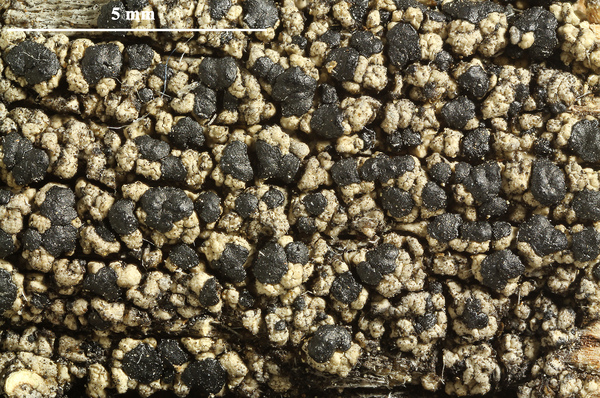Ramboldia elabens (Fr.) Kantvilas & Elix
Lichenologist, 38: 139, 2007. Basionym: Lecidea elabens Fr. - Vet. Akad. Handl.: 256, 1822.
Synonyms: Lecidea enteroleuca f. microcarpa Jatta; Lecidea melancheima Tuck.; Lecidea sabuletorum var. microspora A. Massal.?; Pyrrhospora elabens (Fr.) Hafellner
Distribution: N - Frl, Ven (Lazzarin 2000b, Watson 2014), TAA (Nascimbene & al. 2007b, 2022), Lomb, Piem (Isocrono & al. 2004). C - Sar (Hafellner 1993b, Zedda & Sipman 2001).
Description: Thallus crustose, episubstratic, white to glaucous grey, of contiguous or rarely dispersed, convex, 0.2-0.5(-0.8) mm wide areoles. Apothecia lecideine/biatorine, black, 0.3-1.2 mm across, not or only slightly constricted at base, with a glossy, flat to convex disc, and a shiny, usually thin and inconspicuous, not prominent, finally usually excluded proper margin. Proper exciple prosoplectenchymatous, of radiating, branched and anastomosing hyphae, purple-black and K+ purple in outer part, paler or colourless within, of thin, radiating, gelatinized, elongated, c. 1 µm thick hyphae; epithecium dark olivaceous to red-brown or brown-black, K+ olive-brown; hymenium colourless, c. 60 µm high, I+ blue turning wine-red; paraphyses strongly coherent, simple or sparingly branched and anastomosing in upper part, the apical cells clavate, 4-5 µm wide; hypothecium colourless to pale yellow-brown, I+ blue turning red, with anticlinally arranged hyphae. Asci 8-spored, clavate, the tholus with a strongly amyloid lateral part, a non-amyloid broadly diverging axial mass with a thick, non-amyloid cap above, and a weakly amyloid outer layer Lecanora-type. Ascospores 1-celled, hyaline, narrowly ellipsoid to ellipsoid, 8-10(-12) x 3-4 µm. Pycnidia dark, immersed. Conidia filiform, curved, 11-35 µm long. Spot tests: thallus K+ pale yellow, C-, KC-, P+ red or P-, UV-. Chemistry: thallus with atranorin (major), fumarprotocetraric acid (major) chloroatranorin (minor), protocetraric acid (minor), confumarprotocetraric acid (minor), succinprotocetraric acid (trace), and an unknown depside (minor). Note: a subarctic-subalpine to boreal-montane, probably circumpolar species found on hard wood, often with Calicium tigillare. It is included in the Italian red list of epiphytic lichens as “Vulnerable” (Nascimbene & al. 2013c).
Growth form: Crustose
Substrata: lignum
Photobiont: green algae other than Trentepohlia
Reproductive strategy: mainly sexual
Commonnes-rarity: (info)
Alpine belt: absent
Subalpine belt: very rare
Oromediterranean belt: absent
Montane belt: extremely rare
Submediterranean belt: absent
Padanian area: absent
Humid submediterranean belt: absent
Humid mediterranean belt: absent
Dry mediterranean belt: absent

Predictive model
Herbarium samples


Felix Schumm - CC BY-SA4.0
[20924], Austria, Salzburg, Eastern Alps, Lower Tauern, Lungau Region, 8.3 km NE of Tamsweg, Überling-Sonnseite, Überlingmoos, 47°10'05'' N, 13°54'15'' E, 1725 m, on wooden shingles made of Larix decidua. Leg. R. Türk (no 39669), 3.07.2006, det.R. Türk. LICHENOTHECA GRAECENSIS NR. 476


Felix Schumm - CC BY-SA4.0
[20924], Austria, Salzburg, Eastern Alps, Lower Tauern, Lungau Region, 8.3 km NE of Tamsweg, Überling-Sonnseite, Überlingmoos, 47°10'05'' N, 13°54'15'' E, 1725 m, on wooden shingles made of Larix decidua. Leg. R. Türk (no 39669), 3.07.2006, det.R. Türk. LICHENOTHECA GRAECENSIS NR. 476
Growth form: Crustose
Substrata: lignum
Photobiont: green algae other than Trentepohlia
Reproductive strategy: mainly sexual
Commonnes-rarity: (info)
Alpine belt: absent
Subalpine belt: very rare
Oromediterranean belt: absent
Montane belt: extremely rare
Submediterranean belt: absent
Padanian area: absent
Humid submediterranean belt: absent
Humid mediterranean belt: absent
Dry mediterranean belt: absent

Predictive model
| Herbarium samples |


Felix Schumm - CC BY-SA4.0
[20924], Austria, Salzburg, Eastern Alps, Lower Tauern, Lungau Region, 8.3 km NE of Tamsweg, Überling-Sonnseite, Überlingmoos, 47°10'05'' N, 13°54'15'' E, 1725 m, on wooden shingles made of Larix decidua. Leg. R. Türk (no 39669), 3.07.2006, det.R. Türk. LICHENOTHECA GRAECENSIS NR. 476


 Index Fungorum
Index Fungorum
 GBIF
GBIF








